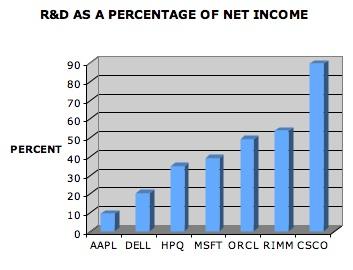In high-tech, breakthrough technology appears to be negatively correlated with R&D expenditure. In this amazing article, how Apple disrupted its market on a shoe-string R&D budget, we see how R&D expenditure (relative to the revenue of the company) does not correlate at all with market breakthrough, on the contrary.

Here is the curve given in the post. Other examples are developed in the post itself like Microsoft – high expenditure, low results.
We know that with the Fourth Revolution looming, the conventional R&D system is broken. The “R&D factories” that were created during the Industrial Age can’t produce the disruptive output we need to make a difference in the world.
As an other example, pharmaceutical companies are also suffering from the obsolescence of the former model where pumping money in R&D would automatically deliver a blockbuster later on.
What is the appropriate new model for R&D and breakthrough innovations?
A first part of the answer could lie in the ‘lean startup’ movement which is currently very trendy. What is the concept about? It says, basically, that prototyping is cheap today. Don’t spend years developing a perfect product you believe the market wants. Come out as soon as possible with a workable product, test your product as soon as you can on the market, and iterate like mad. Apple does exactly that: their products are always missing something that will come in the next iteration. And in the meantime they get plenty of feedback on what to improve.
A second part of the answer will lie in “Open Innovation” or “Crowd Innovation” as soon as it will have found an effective model.
Here is the conundrum: effective R&D (in the sense of market breakthrough) costs 10 times less and is 10 times more effective that what you think.
Should you do more of what you’re doing now or seek a new model for R&D, a model that will bring you through the Fourth Revolution?









